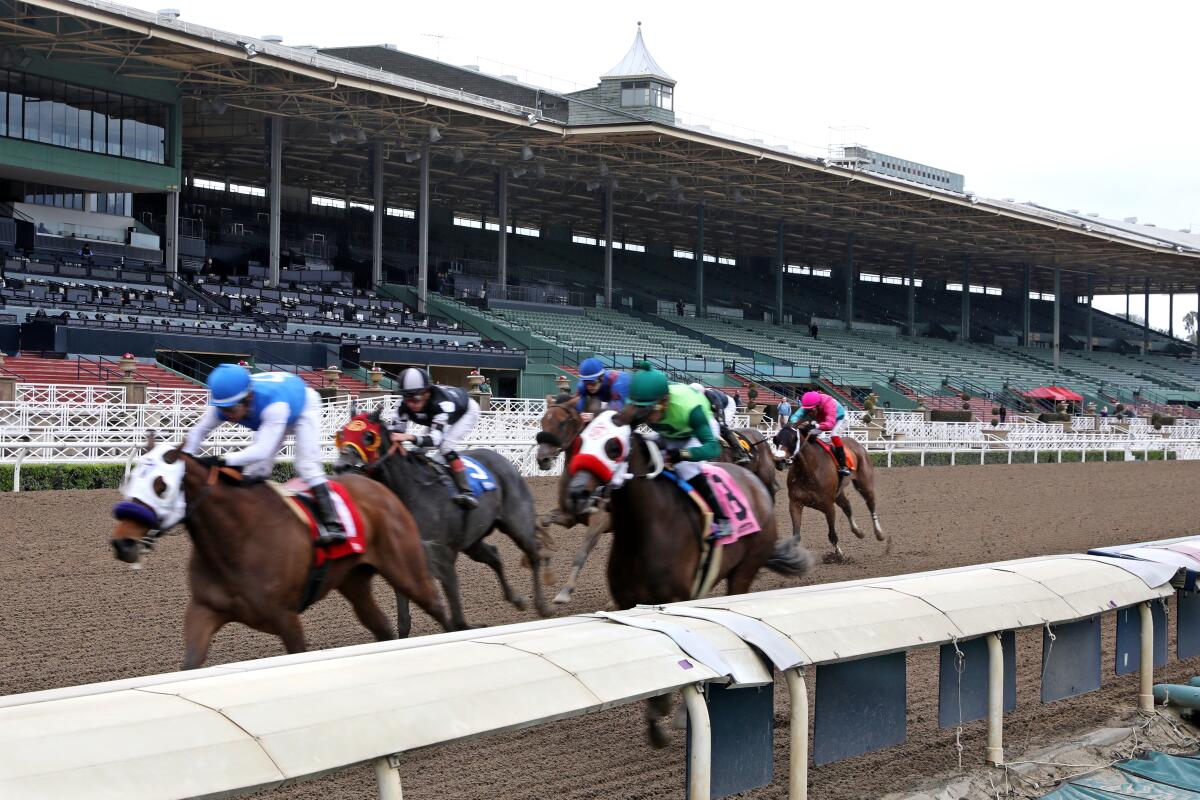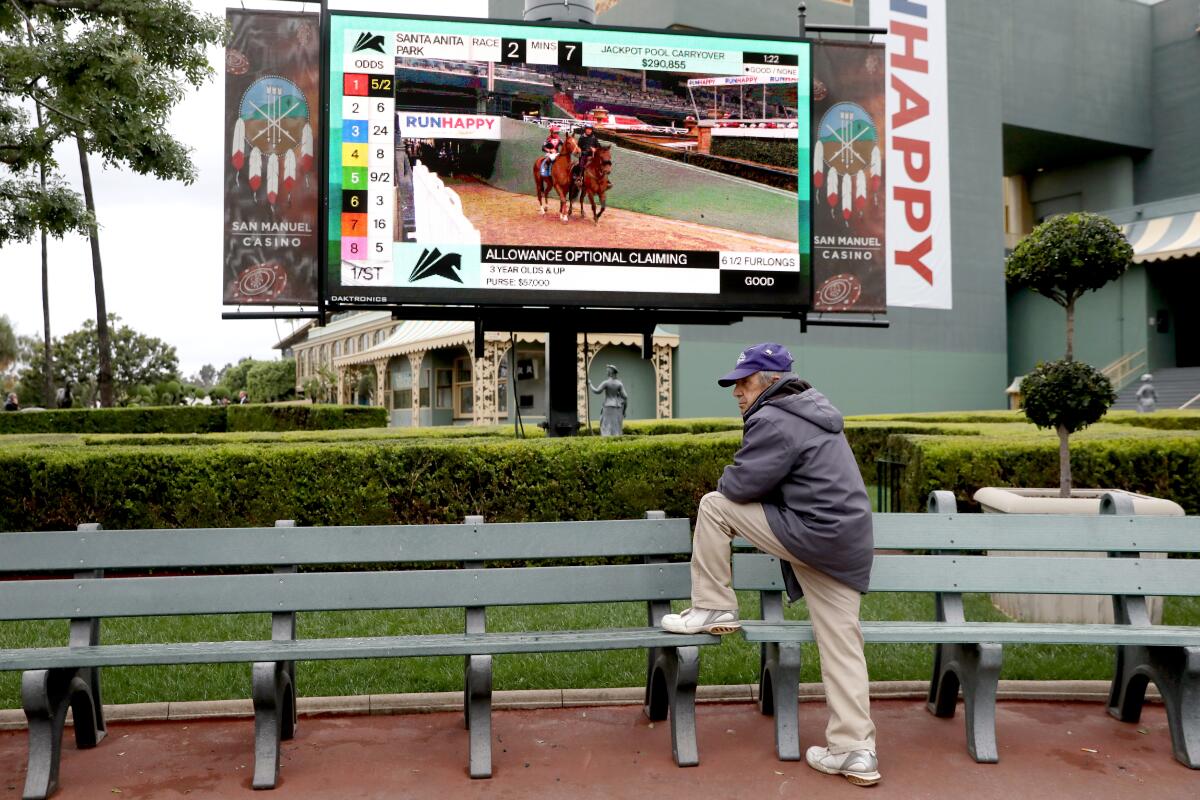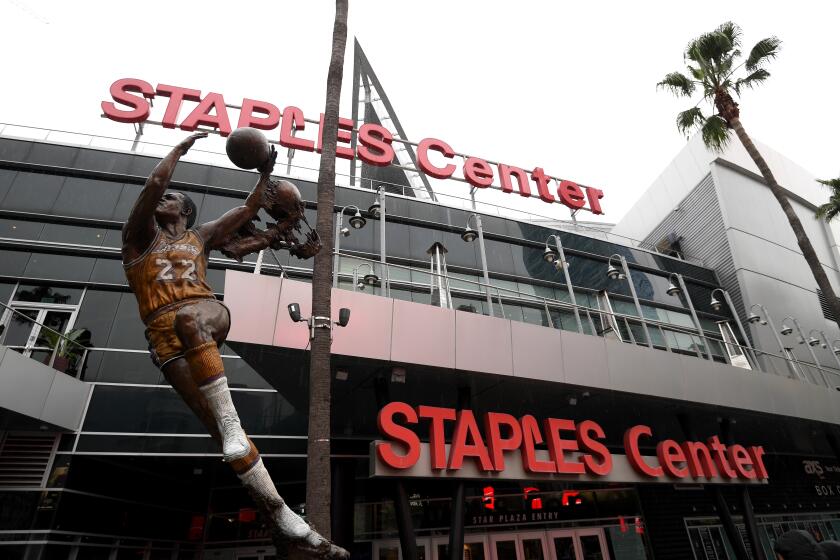Santa Anita, the only game in town, races without any fans

Wonder if they had a horse race and nobody came? Oh, jockeys and the trainers were here, milling about, kicking at invisible things, as if waiting for a bus.
It was a day of invisible things at Santa Anita Park on Saturday, the first race day the historic track held without any fans, a COVID-19 precaution in these cautionary times.
That’s right, no spectators, no on-track betting, no scent of corned beef or clink of ice in a tall, sweaty glass. It was spooky and a tad melancholy. Clouds shrouded the San Gabriel Mountains. After the third race, a gloomy mist settled in.
March sadness.
The soothing acoustics of a day at the races were absent: the murmur of the crowd between starts, the roar of the bettors as the horses flew down the homestretch.
The Clippers, Lakers and Kings, along with Staples Center, have established a fund to provide financial assistance to the arena’s hourly employees.
But it was something — competition, drama, a thread of hope? In the vast empty canyon of American sports, Santa Anita — of all places — provided a sign of life.
And for once in a very long time, horse racing was having a moment.
Helps that you can play the horses from your car or couch these days; 90% of the money bet on a typical race day comes via apps such as 1/ST BET and Xpressbet.
At the track Saturday, betting machines were dark as the skies.
The vibe? Pride that horse racing was hanging in there, mixed with tension over the threat of lost wages for friends and colleagues who work here but are now on furlough.
“It’s very strange,” said horse owner Rick Palmer, standing by an empty paddock before the first race.
“Sad,” said his girlfriend, Kris.

“They feel like glorified morning workouts,” Palmer said after the first couple of races. “I’ve been here when there are more people in the morning workouts than we have here now.”
“It’s weird,” said Flavien Prat, the meet’s most successful jockey, who won again aboard Big Sweep in the third. “Before the race is most noticeable … no sound of the crowd. During the race, you never hear anything anyway, you’re just focused on the race.”
Owners with horses running were allowed to attend races, along with two guests. Visitors are no longer allowed in the stable area, but owners can still check out their horses.
Track officials are particularly worried about the small village of workers who tend to the horses, and live and work in tight quarters.
In all, there might’ve been 100 folks in attendance Saturday, if you include the cleaning crews, which were everywhere. Three hours before the first race, they roamed the stands wiping knobs, desks, TVs, railings, computer screens, tables.
All wore gloves. Some wore masks. They were instructed to “clean everywhere” even though spectators were banned.
The suspension and cancellation of sporting events around the world in the wake of the coronavirus pandemic has hit sports books in Las Vegas hard.
If you saw this coming, raise your hand.
Liar.
No one saw this coming, or knew quite what to do last week when leagues and tournaments started falling by the wayside.
It was beyond comprehension. They stopped March Madness? The NBA? Spring training? Those are our societal safety valves, the way we endure bad times. March is usually a feel-good fever dream.
Now all we have are fevers. And horses, fickle and tender creatures that they are.
Coming sometime soon: The Sound of Silence Handicap.
Note that there’s nothing normal about the new normal. Come to think of it, the old normal wasn’t so keen either. Not for horse racing, which senses an opportunity to snag bettors while other sports remain dormant.
The Stronach Group’s decision to ban fans at Santa Anita preceded similar moves made at tracks across the country, including Golden Gate Fields and Gulfstream, which Stronach also owns, as well as Keeneland.
The aim Saturday in L.A. was business as usual. At 12:30 p.m., 30 minutes before first post, they played the national anthem. A minute later, track announcer Frank Mirahmadi announced changes in the day’s eight races.

“I thought about saying, ‘Welcome to the simulcast from Santa Anita,’” he said. “Our goal is to put on a great show. We know fans are tuning in. My job is to call the most accurate races. I think fans need a good show.”
At 12:50, track trumpeter Jay Cohen double-tongued the usual call to arms. At 1 p.m., the horses stepped off, and for the first time since the 1940s, horse racing was the only game in town.
“It’s bizarre,” said track executive Aiden Butler. “It’s such a complex thing. We have the weather, and on top of that we have a national emergency.
“There’s no reason not to race.”
Horses don’t get coronavirus, and without the crowds, the risks in holding the races were greatly reduced.
But there are inherent dangers to this majestic sport.
This winter/spring Santa Anita meeting has had nine deaths but none racing on the dirt. There have been four on the turf, three on the training track and two training on the dirt.
Last year to this date there were 22 fatalities.
Thoughts of that are never far, especially on a sloppy day. Battle-weary race types like to think the worst is past.
“It’s great that we’ve had such scrutiny,” veteran trainer Vladimir Cerin said after his Time For Suzzie won the first race of the day. “It’s made it better.”
Better enough? The jury — like the crowds — is still out.
Meanwhile, trainer Bob Baffert had a big day, as Baffert often does, his colt Charlatan embarrassing the field in hopes of repeating the Cinderella run Justify had two years ago.
And, speaking of invisible things, a one-eyed filly placed second in the $400,000 Beholder Mile.
With $6.523 million wagered, the track had a larger handle than Aqueduct, despite having one fewer race.
Most important, there were no spills here Saturday, nor signs of surrender, as horse racing celebrated a moment. In many ways, it has never had more resonance than on this soft, muddy day in March.
“It’s been around a long time, and we’re running through all this,” owner Rodney Anderson said. “That means something.”
Staff writer Eric Sondheimer and correspondent John Cherwa contributed to this report.
More to Read
Go beyond the scoreboard
Get the latest on L.A.'s teams in the daily Sports Report newsletter.
You may occasionally receive promotional content from the Los Angeles Times.












